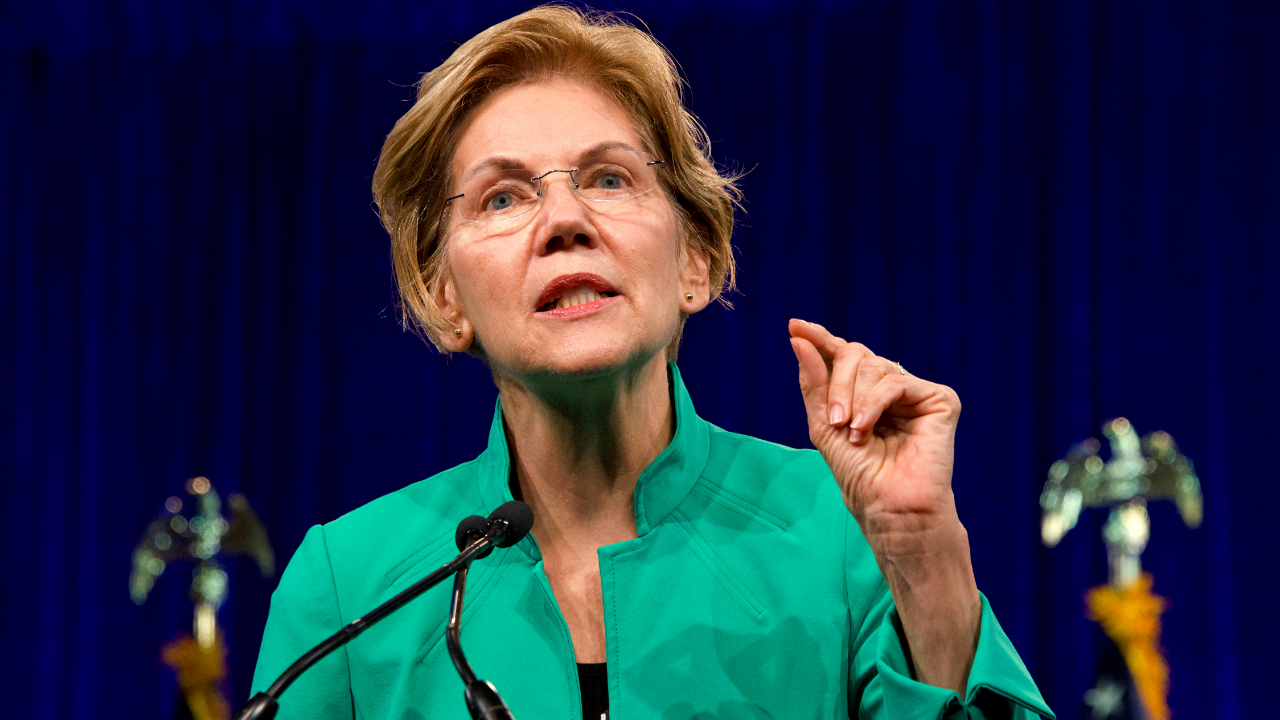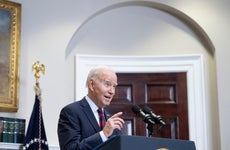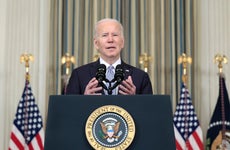Congressional Democrats push for $50,000 in federal student loan forgiveness

The Bankrate promise
At Bankrate we strive to help you make smarter financial decisions. While we adhere to strict , this post may contain references to products from our partners. Here's an explanation for .
Congressional Democrats are again calling on President Joe Biden to use his full executive authority and cancel $50,000 worth of federal student loan debt for every borrower.
Senate Majority Leader Chuck Schumer and Sen. Elizabeth Warren, joined by Reps. Ayanna Pressley, Alma Adams, Ilhan Omar and Mondaire Jones, endorsed a resolution on Thursday that would involve Biden invoking the Higher Education Act of 1965 to cancel even more student loan debt than the $10,000 he initially proposed on the campaign trail. The process would work through an executive order, rather than by signing a bill to law, and was introduced in the last session of Congress.
Legislators pointed to stagnant wage growth and soaring education costs as a reason to act, which have only been exacerbated by the coronavirus pandemic’s economic toll.
“The COVID-19 crisis is worsening the massive inequities in our economy and society, but even before the pandemic the student loan debt crisis was already crushing millions of Americans,” Warren said in a statement. “By cancelling up to $50,000 in federal student loan debt for borrowers, President Biden can take the single most effective executive action available to provide a massive stimulus to our economy, help narrow the racial wealth gap, and lift this impossible burden off of tens of millions of families.”
But the proposal is far from becoming a reality just yet and, at this point, appears to exclude private student loan holders. Here’s what student borrowers need to know.
How the Warren and Schumer plan differs from Biden’s proposals
When it comes to canceling student loan debt, Biden on the campaign trail proposed forgiving “a minimum” of $10,000 on every federal student loan borrower’s balance.
The bulk of his educational policy plans included bolstering public service forgiveness programs, exempting individuals who earn less than $25,000 from making loan payments and making higher education free for households earning less than $125,000 a year.
Yet, none of those proposals made it into the $1.9 trillion American Rescue Plan, Biden’s first order of business for helping families make it through the coronavirus crisis.
In his first day in office, Biden extended a federal student loan forbearance program and interest waiver through Sept. 30.
Forgiveness proposals could wipe out debt for millions of borrowers
A chorus of voices on Capitol Hill are calling on the president to do more. Proponents of the program are using the pandemic as leverage, marketing forgiveness as a clear way to spur demand and stimulate more consumer spending in the recession’s aftermath.
Warren on numerous occasions has also referenced student loan debt cancellation as a path toward improving economic inequalities and the racial wealth gap, given that Black Americans disproportionately have to take out more loans than white borrowers and have higher delinquency rates.
Other analyses differ. Researchers at the University of Pennsylvania’s Wharton School of Business and University of Chicago’s Becker Friedman Institute found that student loan forgiveness could actually widen inequality, with higher earners tending to take out bigger loan balances.
Americans have taken out $1.7 trillion worth of student loans, according to a Federal Reserve survey from Sept. 30. About $1.57 trillion of that comes from the U.S. Department of Education.
The $50,000 forgiveness plan would fully cancel federal student loan debts for close to 80 percent of federal student borrowers, what’s about 36 million people, according to student loan and financial aid expert Mark Kantrowitz. He adds that Biden’s initial $10,000 forgiveness push would relieve all federal student loan debt for nearly a third of federal student loan borrowers, or 15 million Americans.
$50,000 student loan forgiveness: How likely is it?
Upping the ante on student loan forgiveness would also come with a price tag that Biden might not be willing to meet — what Kantrowitz estimates could be close to $1.049 trillion.
Back in December, Biden told The Washington Post he was “unlikely” to cancel $50,000 and questioned his individual authority to do so through executive action.
With Democrats controlling Congress, some level of student cancellation is more possible than ever, though a compromise will be essential with Biden’s other costly legislative priorities, Kantrowitz says.
“Joe Biden’s proposal for $10,000 in student loan forgiveness, which he has reaffirmed a few times, is more likely than not,” he says. “President Biden has a large and expensive agenda, so he will have to prioritize and reduce the cost of his proposals. $10,000 in loan forgiveness can fit; $50,000 cannot.”
Still, representatives of the Biden administration on Thursday urged that he was still keeping student loan forgiveness under consideration while signaling that he might prefer that it come from Congress.
“The president continues to support the cancelling of student debt to bring relief to students and families,” White House Press Secretary Jen Psaki said in a Thursday tweet. “Our team is reviewing whether there are any steps he can take through executive action and he would welcome the opportunity to sign a bill sent to him by Congress.”
While details are scarce, legislators could reduce the cost of a loan forgiveness program with more targeting. Limiting the $10,000 loan forgiveness option to borrowers who owe less than $10,000, for instance, would reduce the price tag to $75 billion, Kantrowitz estimates.
Whether private student loan borrowers also see relief is up in the air, though it’s possible that Congress could widen the terms.
What to do if you need student loan relief right now
Federal student loan borrowers who are able to make payments should consider allocating a chunk of money toward their outstanding balance. With interest collection on hold, your payments will likely go farther, meaning you’ll get rid of your debt faster.
Meanwhile, private student loan borrowers in need of relief should contact their loan servicer about adjusting their payment plan or negotiating a special forbearance program. Even if your lender doesn’t have defined hardship programs, it’s worth a shot to reach out.
“Borrowers should not make decisions based on an assumption that they will get loan forgiveness,” Kantrowitz says. “We do not know if and when it will happen, and whether or how it will be scaled back. They also shouldn’t necessarily make decisions that will affect whether they can get forgiveness, such as refinancing their federal loans into a private student loan.”
Related Articles

The state of student loan forgiveness: What borrowers need to know

Biden launches “Most affordable student loan plan ever” weeks before payment pause ends

Biden administration forgives $1.2 billion in student loans through SAVE Plan

New Biden student debt plan could forgive up to $20,000 in interest for millions